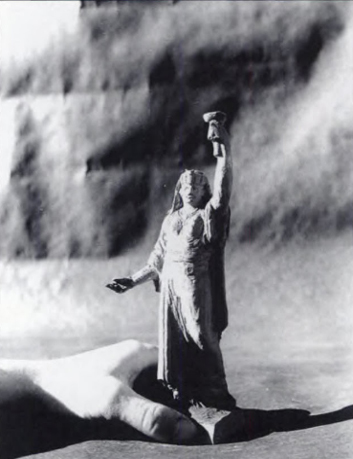The United States has debated immigration since the country's founding, and the Statue of Liberty-a potent symbol for immigrants-is often invoked as an argument for why we should usher in those who seek safety and opportunity with open arms. A littleknown fact about Lady Liberty adds an intriguing twist to today's debate about refugees from the Muslim world: As pointed out by The Daily Beast's Michael Daly in a recent op-ed, the statue itself was originally intended to represent a female Egyptian peasant as a Colossus of Rhodes for the Industrial Age.
That might be surprising to people more familiar with the statue's French roots than its Arab ones. After all, the statue's structure was designed by Alexandre Gustave Eiffel (yes, that Eiffel), and Lady Liberty was given to the United States by France for its centennial to celebrate the alliance of the two countries formed during the French Revolution.
The statue's designer, Frédéric Auguste Bartholdi, was also French, but he found inspiration in a very different place: Egypt. In 1855, he visited Nubian monuments at Abu Simbel, which feature tombs guarded by gigantic colossus figures. Bartholdi became fascinated by the ancient architecture, developing what the National Park Service calls a "passion for large-scale public monuments and colossal structures." Eventually, he channeled that passion into a proposal for the inauguration of the Suez Canal.
Bartholdi envisioned a colossal monument featuring a robeclad woman representing Egypt to stand at Port Said, the city at the northern terminus of the canal in Egypt. To prep for this undertaking, Barry Moreno, author of multiple books about the statue, writes that Bartholdi studied art like the Colossus, honing the concept for a figure called Libertas who would stand at the canal. "Taking the form of a veiled peasant woman," writes Moreno, "the statue was to stand 86 feet high, and its pedestal was to rise to a height of 48 feet." Early models of the statue were called "Egypt Carrying the Light to Asia."
Edward Berenson, author of Statue of Liberty: A Translatlantic Story, writes that Bartholdi's concept morphed from "a gigantic female fellah, or Arab peasant" into "a colossal goddess." But Egypt, which had invested enormous amounts of time and money into the landmark canal, was not as eager about Bartholdi's idea. Isma'il Pasha, the reigning khedive, rejected the plan as too costly.
Eventually, a 180 foot tall lighthouse was installed at Port Said instead. But Bartholdi was not discouraged. He eventually repurposed his concept into "Liberty Enlightening the World"-the official name for the statue that has been overlooking New York Harbor since 1886.
Source: Smithsonianmag.com


CBS News